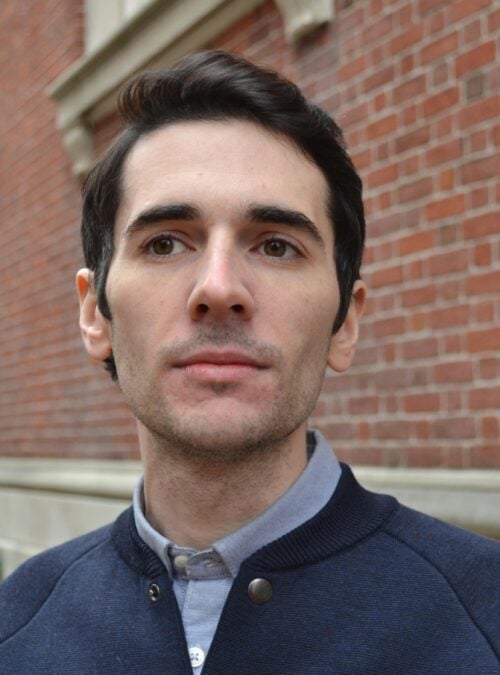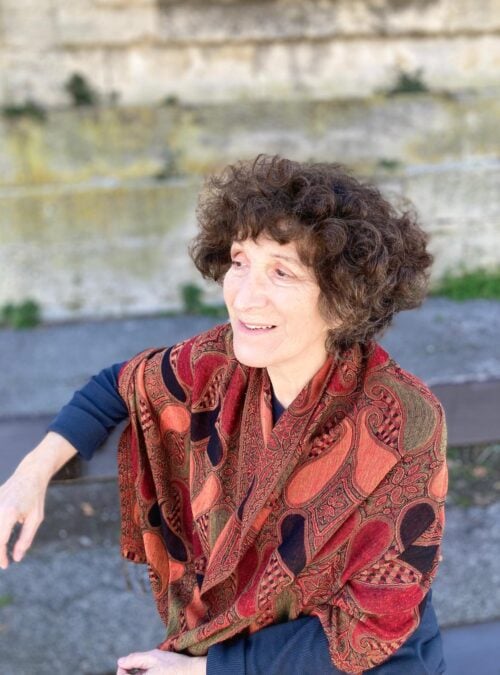Montale, a secret Leopardi? An Interview with Jonathan Galassi
Author: Dalila Colucci

In his essay on the translation of the first book of the Odyssey into Italian (Saggio di traduzione dell’Odissea, 1816), Giacomo Leopardi declared that talented translators do not talk about their method: “Del modo di tradurre […] ne parla più a lungo chi traduce men bene.” After all, every good translation is something close to an alchemic process, a loving act that defies theoretical discourse. Jonathan Galassi – the legendary president of the New York publishing house Farrar, Straus and Giroux, where he has worked since 1986 – knows it well. He has spent the last thirty years in the passionate endeavor of translating two great Italian poets: Eugenio Montale, to whose major works Galassi has dedicated the Collected Poems 1920-1954 (FSG, 1998) and the Posthumous Diary (Turtle Point Press, 2001); and Giacomo Leopardi, of whom he has translated the Canti, appearing in 2010 from Farrar, Straus and Giroux. A year later FSG published the first integral English version of the Zibaldone, translated by several hands. These are highly cultivated translations, developed alongside an autonomous creative activity, intensely lived as an existential vocation and resulting in three refined poetry books: Morning Run (1988), North Street (2000), and Left-Handed (2012)–as well as a comic novel about poets and publishers, Muse (2015). We would search in vain for methodological indications in the concise and beautiful introductions, or in the very rich commentaries that accompany Galassi’s titanic efforts of transliteration. We will rather discover, as it happens at the end of the foreword to the Canti, the invitation to try, albeit again in vain, to reproduce the inimitable: “Let the translation committee form and reform, trying ‘in vain’ –one of Leopardi’s favorite phrases –to catch his inimitable sound. However we fail, we are the better for it” (p. XXV). Nonetheless, in view of the publication, for Everyman’s Library Pocket Poets Series, of a selection of his translations from Montale (Montale: Poems, April 2020), I have tried to ask Mr. Galassi some questions on his career as a publisher and translator. One cold but clear February afternoon, he has welcomed me in his office on the twenty-fourth floor of the elegant skyscraper at 120 Broadway, the new home of Farrar, Straus and Giroux.
You are perhaps the single individual who, in recent decades, has most supported and spread Italian literature in the United States. As president of Farrar, Straus and Giroux, you have promoted the translation and publication of great authors from the past and present, such as Alberto Moravia, Melania Mazzucco, Valerio Magrelli, Patrizia Cavalli, Roberto Saviano, Edoardo Albinati; and you have made your own extraordinary contribution as a translator of Montale and Leopardi. How did you develop such a passion for the Italian culture and literature, alongside a specific translation interest in a niche genre like poetry – and Italian poetry in particular?
J.G. – My grandfather was Italian: he came to America when he was thirteen years old in 1900. My father had studied Italian in college and I grew up in a house filled with books about Italy, in a family that always emphasized the greatness of Italian art and culture. After graduating from Harvard, I got a fellowship to go to Cambridge, UK, and for spring vacation that first year, I went to Rome. I had never been to Europe before and I was overwhelmed by what I saw, by its incredible beauty, so I decided to go back that summer, this time to Perugia’s Università per stranieri, where I started to study Italian. When I returned to Cambridge, I began to take courses on Dante and other Italian subjects. I went back to America after two years, to Boston. I knew that I did not want to continue an academic career, but I had been writing poetry and had a strong interest in it since I was an undergraduate. Around that time, I was reached by a friend, Frank Bidart – now a Pulitzer-winning poet, then as now teaching at Wellesley – who was preparing an issue of a magazine called Ploughshares, in Boston. He asked me to translate the Xenia poems of Montale for this issue and this was my first translation project: it was my introduction to the translation of poetry and to Montale, in fact. At that time, I had started working in publishing at Houghton Mifflin, an old Boston company. The convergence of my interest in poetry, my passion for Italian, and my work as an editor allowed me to keep working on translation. I started out by working on Montale’s essays. In a way, I more or less learned Italian through that translation. Eventually, Montale won the Nobel Prize in 1981 and Ecco Press published my collection of Montale’s essays the next year (The Second Life of Art). Meanwhile, since 1981, I had moved to Random House, where I published, among others, the last book by Elsa Morante, Aracoeli (1984). And eventually I published the translation of Montale’s last book, Altri versi (Otherwise: Last and First Poems of Eugenio Montale, Random House 1984). Then, in 1986, I came to Farrar, Straus and Giroux, which had a long tradition of publishing translation, in particular from Italian. They had published Carlo Levi, Moravia, Ungaretti, and Quasimodo among others. Eventually, I decided that I would work on Montale’s major poetry. It took me thirteen years to complete that project: the Collected Poems 1920-1954 appeared in 1998. That is the biggest thing I’ve ever undertaken and I worked for many years on both the translations and the annotations, reading much of the major criticism of Montale.
When embarking in this project, what kind of final product did you have in mind? In other words, what type of translation did you aim to achieve?
J.G. – One thing that people always say is that Montale’s difficulty lies in the great variety of registers and idioms that he employs, resulting in the obscurity of his poetical message. But everything that Montale says is for a reason; it is not obscure for the sake of obscurity. What I wanted to do in my translation, of course with the help of the notes, was to clarify what exactly he was saying, to draw back the veil on the so-called obscurity of his poetry. That was really my task: to try to translate clearly but also to explicate, with the help of the notes.
Indeed, Montale’s poetry needs decoding. In this perspective, I found particularly successful your translations and commentary of the Mottetti, which represent Montale’s highest and most encoded poetry, to approach which the reader needs an explanation that touches all hermeneutic levels, from lexical and biographical annotations, up to semantic and formal indications. What kind of relation do you have with this particular Montale and how was it possible to translate all his complicated background for the American readership?
J.G. – The poetry of the Mottetti is difficult on purpose, it is a trobar clus: Montale is adopting the Stilnovistic tradition to write about an illicit love, but there is also a political subtext, as well. So his style mimics and draws from these situations and I am not sure he necessarily intended to be fully understood at all times. Montale, after all, is always the poet of the few, so maybe these are secret messages in a way, and the secrecy is part of the attraction. Of course, today that is not true anymore. Dante Isella has done a very thorough edition of the Mottetti, which I used when preparing my translation, although my work ended up being different. Translating (and explaining) the Mottetti for the American public may be more complicated but it may also be simpler, because this poetry presents different levels of difficulties for an Italian that are not there for an American reader. Let’s take, for instance, the fourth poem of the Mottetti (Lontano, ero con te quando tuo padre), which is one of the most obscure and where place names like Cumerlotti and Anghébeni should, for an Italian reader, make significant reference to the brutality of WWI. For an American, instead, these are just names and they rather participate in that ‘mystique of names’ that in Montale works with a sort of Proustian effect. In any case, some things always have to be sacrificed, in a translation, and this can help to facilitate the understanding of one level, say the primary level, of the original meaning.
In the beautiful preface to your 1982 translation of Montale’s essays, The Second Life of Art, you wrote: “modern Italian culture for clear economic and historical reasons has had a more limited currency abroad than the other major European brands of civilization, and, much as Montale played an important part in bringing modern Italian letters into the international mainstream, the tradition out of which he wrote is familiar to few non-Italians” (p. XII). Following this statement, what could you say about the role of Italian literature today, on the American scene? And how did Montale become well-known in the English speaking world?
J.G. – Well, there is an Anglo-Saxon mystique of Italian culture, on a certain high cultural level. Everyone who has any kind of education wants to go to Italy. Everyone is aware that Dante is one of the greatest poets of the Western tradition, although they might not know it first-hand. As for Montale, I have explained how he became known in the English speaking world in an essay that I wrote for the New York Review of Books in November 2012 – entitled “The Great Montale in English” – which was a review of William Arrowsmith’s translation of The Collected Poems of Eugenio Montale, 1925-1977 (published by Norton that year). There, I spoke about the fact that Montale has a wide currency among poets here, especially those of a generation back. He won the Nobel Prize, and before that Robert Lowell translated many of his poems. There are more Montale poems in Lowell’s Imitations, which are his particular kind of ‘translations’, than almost any other poet, and I think this is what first put him on the map for us. As a result, a lot of American poets have been interested in Montale and translated him and thought of him; and several different groups appreciate him for multiple reasons: the objectivist poets love Montale for his use of the image; other poets, like Lowell, who comes from a very different tradition, admire his classical background, his deep eloquence. But, again, Montale’s roots are derived from an Italian tradition which is ultimately not really accessible to non-Italians. Of course, Montale started out being a neo-impressionist, a neo-French poet, as a young man; then he went to Trieste and there he experienced the prosaic influence of authors like Svevo and his friendship with people like Bobi Bazlen, that broadened his views. But his later and deeper influences are Italian: after all, Le occasioni is really a book about Dante, about the Stilnovisti. There’s always una donna che non si trova in Montale, and this is a thing he shares with Leopardi: this notion, this situation, lies at the heart of the Italian lyric tradition, which starts with Dante and Petrarca and goes all the way down to Montale. Then there of course is his later period of “metaphysical” poetry, very influenced by the English Renaissance; but his friendship with Contini, who was preparing his edition of Dante’s short poems in the 1930s, was deeply influential for Montale. That relationship ultimately re-centered him in the Italian tradition and the hidden trobar clus that he took advantage of, given the secrecy that he needed for both political and personal reasons.
You have defined Montale as “the greatest Italian poet since Leopardi,” in the introduction to The Second Life of Art (p. XII); and Leopardi as “Italy’s first modern poet,” in your introduction to the Canti (p. XIII). Nonetheless, much more than Montale, Leopardi seems traditionally ‘limited’ to an Italian readership: interest in his poetry arrived quite late in the Anglo-Saxon world and, before your 2010 version of the Canti, there had been very few, only partial, and poorly circulating translations. Why is this and, more importantly, what led you to bet on Leopardi?
J.G. – As for translations of Leopardi, there was certainly the one by John Heath-Stubbs (Poems from Giacomo Leopardi, 1946); but I don’t think it was a complete one, as you said. The reason for a more limited circulation of Leopardi’s poetry is probably to be found in the fact that, throughout the nineteenth century, Leopardi was seen in Italy and abroad as a hero of the Risorgimento, for clearly political reasons: as a hero of civil liberation, of the creation of an Italian state, modelled on ancient Rome, against the old monarchic and Papal colonizing regimes. He was seen as part of the liberalization of culture in Europe, and not so much as a poet of personal pain, which is what has come to matter more to us today. There are of course several different Leopardis: there’s the civil, public, rhetorical, exhortatory poet and there’s the private, maladjusted, suffering poet. And today, I think, Leopardi is recognized as the forefather of Romanticism, as the proto-modern poet, because he created a suffering I. Who else really did that before him? He was the first. If Leopardi had only been a civil poet he would be an historical figure. But the problem with Leopardi as a poet for the moderns is that part of him is so retrograde: in some moments he is still an eighteenth-century writer, thus part of his rhetoric is very hard to translate, because we don’t talk that way anymore. But the poet of the idylls, and the one who combines the two instances (the civil and the private), as in La ginestra…that is really what all poetry is today and it comes out of him. What is Pasolini, for instance, but a latter-day Leopardi?
So, that is why you decided to embark on Leopardi’s translation: to retrace the origin of the poetry of the self?
J.G. – No, it actually was for an ignorant reason. After completing my Montale book, I wanted to do something new but I couldn’t find a twentieth-century poet whom I loved as much as Montale. So I decided I would go backward; Leopardi had written only forty-one poems and I thought I could work on this limited project. In fact, my friend the great translator and novelist Tim Parks had asked me to work on a version of A Silvia to publish along with an article he was writing, and that is what got me started. And then of course, when it was too late, I found out how terribly, impossibly hard his poetry is. It was a very difficult project for me. Shorter, but more difficult in a way, and I would say that I am less fully satisfied with my result with Leopardi than I am with Montale.
It was certainly a big change. One might even say that Montale and Leopardi occupy the opposite sides of a spectrum, for stylistic and lexical reasons. Montale is a poet whose style changes significantly from the Ossi di seppia to the Diari, but always remains characterized by a great realistic and linguistic precision, while Leopardi is a champion of vagueness and indeterminacy. Not only that: where for Montale poetic architecture, its rhythm, and its artifice are especially important, the key to Leopardi’s poetry lies not so much in its form but in what you have called an “impenetrably perfect, sonorous expressiveness” (Canti, p. XXII). How did you manage your way from Montale to Leopardi and how did your way of translating change from one to the other?
J.G. – This is a really difficult and good question. As I mentioned before, in some ways I am happier with my result with Montale because once you “get” his tone – that alienated, ironic disappointment, that attitude of a believing unbeliever – you have really found the key to his poetry. Montale’s tone is consistent, is always the same; and so are his fundamental themes: the dilemma of the modern man, trapped between the past and the future, faith and disbelief, where irony is essential and pervades everything. It’s remarkably consistent: if you get inside that, you can live there. It takes various forms and manifestations, of course, in different periods of his work, but the core is unchanged – now, for instance, I am working on his later poems and it’s very distinctive and yet also fundamentally the same. With Leopardi, instead, I had other goals. Maybe the basic intention was the same: once again, to make clear what he was saying. But All’Italia is such a different animal from Alla luna…there are so many different styles (some are not even really very good, as in Consalvo). He is always experimenting. There is a core too in him, but it is in his sound and it is extremely difficult to write that melodically in English and still make sense.
Let us go into the details of the texts now, or rather of a particular text: L’Infinito, perhaps the most untranslatable poem in the history of Italian literature. You offered a beautiful translation where, nevertheless, as you have mentioned above, some aspects of the original meaning are sacrificed to preserve the beauty of the rhythm. I was interested, in this respect, in your translation of “io nel pensier mi fingo,” on line 7, which in the English version becomes “I can see / beyond, in my mind’s eye,” spread among lines 4 and 5. Beyond the perhaps necessary anticipation of the main verb (as the English syntax requires), why did you choose to use the verb to see? Why, in other words, to emphasize the ‘seeing with the mind’ as opposed to the ‘pretending in the imagination’ suggested by fingo?
J.G. – L’Infinito is the first translation I ever did in Italian. Leopardi wrote it when he was twenty-one, and I was twenty-two when I translated it. And when I published it later on, I only changed one or two words. I was trying to do poetry; you know, for me being a translator is always about trying to do poetry. And, although it is so difficult to render, there are more translations in English of L’Infinito than any other Italian poem! As for “in my mind’s eye” that is an English idiom that I liked that because it preserved the original rhythm; and to me it is not the see that’s the problem, but the I can see, which is perhaps a static thing, as opposed to fingo, which is an active verb, implying not just simulation and/or imagination, but creation (being rooted in the Latin fingere = to make). Fingo is “I do something”, “I make something.” Fingo is also about fiction (fiction comes from fingere): it is incredibly polysemous. But how to convey all this, preserving the rhythm? You have to sacrifice something. In a way, it’s almost easier to translate Latin than it is to translate Italian, because Latin has sources too, of course, but it’s not as polysemous.
Every poem, after all, implies a language problem: the language of a poet – to put it with Montale’s words from Intentions (an imaginary interview from 1946) – “is an historicized language, a relationship. It is valid to the degree that it opposes or differentiates itself from other languages.” The problem, as I see it, is that literary Italian is extremely historicized, culturally and geographically fragmented and multifaceted, rooted in archaic tradition (especially in poetry) even if the spoken language has evolved. Leopardi uses a language that is not spoken anymore in his time, and so does Montale…
J.G. – Yes, but it is different when they do it. When Montale does it, he does it ironically. Contini said that Montale’s language is at the breaking point of cultural saturation: that is, the cultural content in his poems is too much to contain in purely spoken language, so there is always a critical awareness of what is being said. And I think that part of the difference with Leopardi is that Leopardi’s cultural baggage is very different from Montale’s: first of all, it’s very classicized and it also draws from eighteenth-century poets we don’t even read anymore. So, it’s a different register, with different intentions. In Montale, everything is dripping with reference, with meaning. You can’t bring it all across, but there is a knowingness in Montale, and that you can translate: you can’t bring forward the actual stuff that is in the package, but you can convey the idea that there is a package. This is translation: lifting this up and plopping it down into your own language and cultural realities.
In this sense, what can Montale and Leopardi – and their complex relationship with reality – give to the American reader today?
J.G. – I think Leopardi gives to every reader in all languages the anguish of being an I, of being a suffering individual, of being torn out of an idealized world. I think that is what is modern about him and it is something conveyable to everyone: you may have to give up a lot of registers, but this is utterly translatable. And I do think he is the first Romantic, really. Montale is an alienated thinker, an insecure lover, often torn between two women, two situations (Clizia and Mosca, God and not God). He’s neither ancient nor modern, he’s neither red cleric nor black: he is something different, but he partakes of all these things and witnesses them, he’s aware of all that isn’t possible (quel che non siamo, quel che non vogliamo) and the situational irony which results is what he is. He carries it all with him. A lot of people say that Montale is a secret, a covert Leopardi. He doesn’t talk much about Leopardi, but you can say that their basic situations are ultimately very similar. I also think that Montale has been underwater for the last forty years, at least outside Italy; in the last five years there have begun to be more studies of Montale, but during the deconstructive period and also after his death he has been forgotten. He is starting to come back now, but it has really been a long time. Maybe, it is because he is too great: being a poet post-Montale has been a very difficult task.
You are a poet post-Montale yourself. Your first book of poetry came out more or less simultaneously with your first translations of Montale. What is Montale’s influence in your poetry?
J.G. – Well, I wrote some poems that were actually imitative of Montale’s imitations of English poems. North Street, for example, contains a very Montalian one: The Necklace. As suggested by the title of the section in which the poem is included, the “lacquer seeds” of the necklace – signs of an “elusive essence,” “little worlds” of feelings and effort – are Rayograms: that is, photographic abstractions created only once through the interposition of an object in between light and photographic paper. They are unique symbols of an emotional contact, aspiring oxidations of a “dented life,” which recall Eliot and then Montale’s use of the objective correlative.
Besides Eliot, what other English and non-Italian poets influenced most Montale’s poetry, in your opinion?
J.G. – Montale’s sonnets in La bufera are very influenced by John Donne and Shakespeare; and he translated the latter, of course, probably with the help of Lucia Rodocanachi. His English wasn’t very good, after all; if you read his letters to Clizia, you’ll have proof. Thus, he must have necessarily relied on translations or translators. I believe that would be a very interesting subject to explore: if you were going to read John Donne, in Montale’s time, who would have been your translator? Leone Traverso was a wonderful translator for German, for instance, and Montale could certainly rely on him, but for English there must have been other people. In any case, Montale is always influenced by other poets: be it Rilke, Donne, Höelderlin, or the Stilnovisti, or the occasional “sonnets” of Robert Lowell, which certainly influenced the Diari, he is always “stealing” from others. As Eliot said, it’s what great poets do. There is an enormous debate about appropriation now in American culture, but it is so stupid. Culture is appropriation. Ossi di seppia is all about D’Annunzio…appropriating, responding, is what poets do and Montale did it better than almost anyone.
As Montale reminds us, poetry always lives in a special connection with prose: “Naturally, the great seedbed of every poetic invention lies in the field of prose. At one time everything was expressible in verse, and these verses resembled, and sometimes were, poetry. Today only certain things are said in verse” (Intentions). In light of this contamination, what kind of relationship exists between poetry and prose in the act of translation? I am thinking, specifically, of the connection between Montale and Leopardi’s poetry with prose collections such as Il secondo mestiere and the Zibaldone.
J.G. – Montale wrote a huge amount as a journalist and is a wonderful prose writer. But he is not like Leopardi: he is not a philosopher, he is writing about art, not ideas per se. And he is a cultural conservative first. Leopardi, instead, had one foot in the past and one foot in the future. The more you read about both of them, in any case, the more you learn about their worlds, where they come from, and what they are talking about. This goes back to what I said in the beginning: the thing I really wanted to do as a translator was to convey what they were actually saying, and that is as prosaic goal, in a way. Still in a poetic translation you have to have both. That’s what I tried to do in my Montale translation: I tried to make it clear, but also have intrinsic rhythm. The best review I had of my Montale book was from a Canadian poet, Eric Ormsby, who wrote that I had created rhythmic equivalents for Montale’s poems. That’s what the translation has to do: make sense and maintain the inner compulsion of the rhythm, even if the rhymes have to be sacrificed. Interestingly, one thing that Italian people always say about Montale is how rough – aspra – or unliquid his poetry sounds, whereas to us English speakers, he is so very musical! Montale maybe has a more difficult music, but we don’t hear that quite as distinctly because it is still pretty liquid to us. Leopardi’s poetry is even more liquid than Montale’s; but at the same time, there is much of the prosaic in how inventive he is with form: for instance, he gives up rhymes and subtly cracks the inner and outer structures of the poetic tradition he grew up with. So he is very radical as a writer and that is prosaic too! Leopardi and Montale are ultimately two sides of the same coin and that is why I sometimes think of Montale as a secret Leopardi.
Would you like to tell us about this new Everyman publication of your Montale? How does it resemble or diverge from the previous ones?
J.G. – It is basically taken from the Collected Poems: it is a selection from that, without the original Italian text, but with notes. So it’s a reduction, a distillation. I’m currently working on the second volume of Montale, from Satura onward; I already have a draft, but I need to complete the annotations.
Finally, a question of an almost existential nature: what do you think is the human and social value of poetry today? And what is its editorial future?
J.G. – Poetry’s value today is the same that it has always been: it distils a culture’s preoccupations, history, aspirations, problems. It captures our essence more efficiently and memorably than any art. That’s why it is so often quoted as representing a particular moment, an outlook—“what oft was thought but ne’er so well expressed,” as Pope put it. This happens whether we intend it or not. Poetry goes in and out of fashion. Right now there’s a huge amount of poetic activity in our country. Most of it is probably not destined for immortality, but some of it certainly is. When you see how a poet like Terrance Hayes, to name just one great contemporary, makes sense of our confusing, terrible world you know that poetry is still doing its job. Montale was brilliant about this in his prose writings. Poetry is the most portable and stealthy of the arts. It thrives on discouragement. Its editorial future is what it is. I’m not worried about it. I’m worried about our world, about us. But one thing I’m not worried about is poetry.










